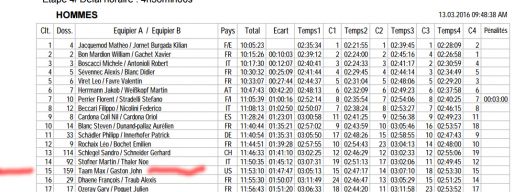Exciting race results from Europe. Specifically, IMHO Mac Daddy of all comps Pierra Menta. The race has hundreds of participants — including a large leading field of Euro national team racers. Guess who got 15th place? A couple of U.S. residents who hail from WildSnow home turf, specifically John Gaston and Max Taam. Easily one of the best North American finishes ever in a big European race (one wonders, did they have guys falling all over them to sign for sponsorships?) We are so proud and impressed. CONGRATULATIONS! More, we had another local team in the race as well, Paul Hamilton and Scott Simmons came in at spot 41 and from Scott’s FB reports it appears they had the time of their lives.. We do not have a lot of skimo racers in the U.S., but apparently our culture of athletic excellence is representing quite nicely. Oh, and let’s give a cheer to that incredible Axelle Mollaret & Laetitia Roux, winners on the female side. I just keep wondering if Lisa could ever convince Laetitia to visit Aspen, perhaps those jokers at Cripple Creek could get her to do a podcast? Doug?

Pierra Menta top results 2016. Check out Jaquemod and Jornet’s winning time, though be advised it’s a 4 day race so the spread becomes large by the last day. Click to enlarge.
Official Pierra Menta website here. But check out these videos, can you imagine being a racer, with all those spectators cheering you on?
Flip back to Colorado U.S.A.. If you appreciate our state avalanche forecasting and education efforts, they’re pushing a fundraising campaign. Donate here.
Swing on up to Canada. Despite many claim to the contrary, Whistler might actually be the Chamonix of North America. I base that on the amount of cable accessed alpine ski touring and entrenched guide culture, along with access to actual glaciers. This is a good “travel” style article from a newbie who hired one of the elite to show him around.
I missed the below vid released in January, made by a “bumper drone” flying through a Swiss glacier crevasse. One does wonder at why the craft has to bump into every wall, and the music is nothing less than bombastic. But in its own way, kinda cool.
Lastly, here is something interesting regarding “leadership.” In the early days of mountaineering instruction, generations such as us baby boomers learned that nearly every group should have a “leader,” and that leader was best formalized during the planning stages at home. This was especially true for expeditions, and was an essential part of what we learned for “emergency procedure.” If you were in a rescue situation, for example, we were taught that the first thing you did was appoint or otherwise acknowledge a leader. I worked for a while teaching for the National Outdoor Leadership School, and the word “Leadership” wasn’t in that name by accident.
These days, especially with the latest generation of adults, the concept of a group leader is often ignored unless a hired guide is heading things up, or one individual is wearing a strong “expert halo” compared to everyone else.
When I climbed Denali in the 1970s, we designated an autocratic and “real” group leader. Doing so was something all of has been taught as a non-negotiable essential for any group larger than a pair of peers. On the ground, the leadership process was democratic to a degree but the leader had final say by everyone’s prior agreement. We made the summit but had quite a bit of group dissension despite our best intentions about leadership.
Fast forward to 2010 when I skied Denali with my son and a group of his generation. We had no formal leader, everything from task delegation to final packing was a peer-to-peer process. I recall the Park Service paperwork made us appoint one person to somewhat of a leadership position, which felt strange after I’d adjusted to the group process. (During the trip I did act as a tribal elder on a few occasions, though the group process seemed to work well).
So, regarding the somewhat forgotten concept of outdoor leadership I was surprised this morning to see this article in the Vail newspaper by John Dakin, covering issues of leadership in backcountry riding. I grew up on these concepts, taught them at NOLS and Outward Bound, and continue to ponder the issue of how leadership (informal or formal) influences the backcountry recreation experience — especially safety. How about you guys? What’s your philosophy when it comes to outdoor leadership? How do your groups operate?
Swing back to skimo. If you track ultra running you know about the Hardrock 100 held in the Colorado mountains every year. How about skiing the course instead of running it? That’s the plan.
WildSnow.com publisher emeritus and founder Lou (Louis Dawson) has a 50+ years career in climbing, backcountry skiing and ski mountaineering. He was the first person in history to ski down all 54 Colorado 14,000-foot peaks, has authored numerous books about about backcountry skiing, and has skied from the summit of Denali in Alaska, North America’s highest mountain.
